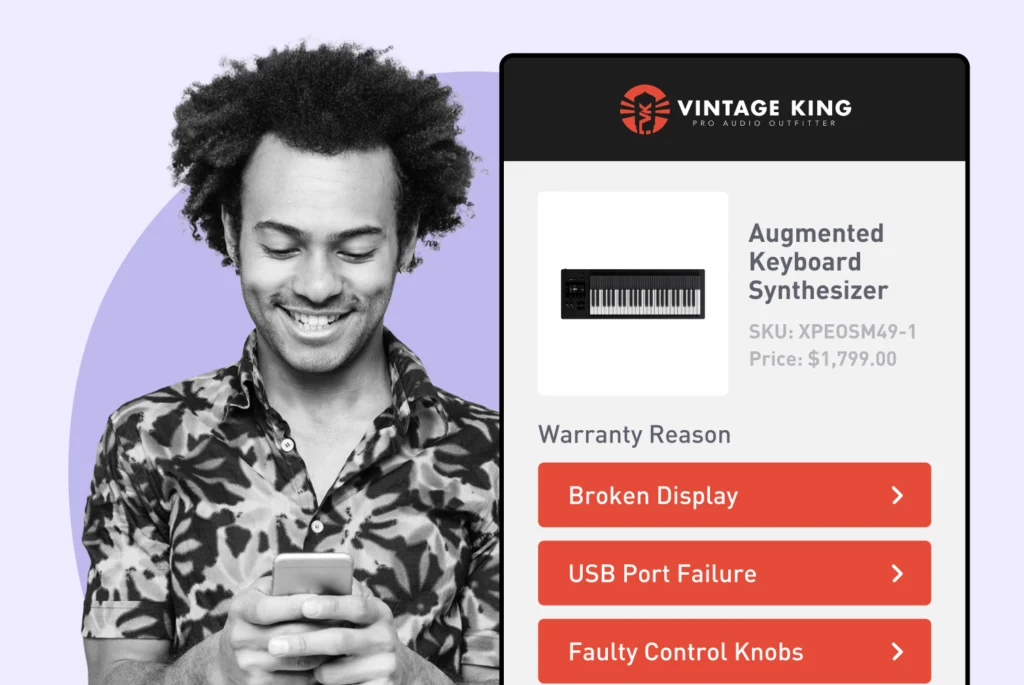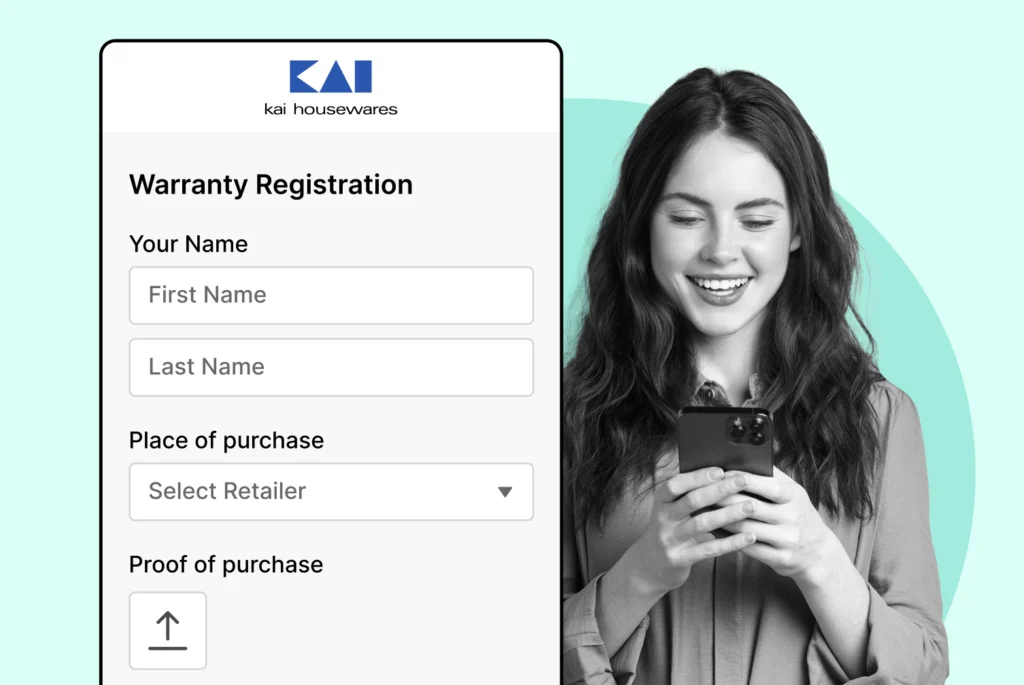
How to Reduce Warranty Fraud in Your eCommerce Store
Discover effective strategies to combat warranty fraud and protect your business. Learn best practices for prevention and safeguard your assets. Read more!
Shipping, Tracking & Notifications
Boost customer experience and reduce support tickets
Realtime order and shipment tracking
Proactive order and shipping notifications
AI-Enhanced Discounted Labels
Predictive pre-purchase estimated delivery dates
Self-Serivce branded order tracking
Effortless experience delivered
Identify and Resolve Order Issues
Realtime order and shipment tracking
Make returns profitable and delight customers
Flexibility to define any return destinations & conditions
Simplify returns for your customers and team
Incentivize exchanges over returns
Returns management made easy for your team
Returns management made easy for your team
Easy claims and smart upsells
Understand why your customers are returning
In-Store & Curbside Pickup
Unify the online and the in-store experience
Hassle-free pickup experience for customers
In-Store dashboard to keep operations streamlined
In-Store and Online orders unified
Drive foot-traffic to your stores
Shipping, Tracking & Notifications
Boost customer experience and reduce support tickets
Realtime order and shipment tracking
Proactive order and shipping notifications
AI-Enhanced Discounted Labels
Predictive pre-purchase estimated delivery dates
Self-Serivce branded order tracking
Effortless experience delivered
Identify and Resolve Order Issues
Realtime order and shipment tracking
Make returns profitable and delight customers
Flexibility to define any return destinations & conditions
Simplify returns for your customers and team
Incentivize exchanges over returns
Returns management made easy for your team
Returns management made easy for your team
Understand why your customers are returning
In-Store & Curbside Pickup
Unify the online and the in-store experience
Hassle-free pickup experience for customers
In-Store Dashboard to keep operations streamlined
In-Store and Online orders unified
Drive foot-traffic to your stores
Boost customer experience and reduce support tickets
Realtime order and shipment tracking
Proactive order and shipping notifications
AI-Enhanced Discounted Labels
Predictive pre-purchase estimated delivery dates
Self-Serivce branded order tracking
Effortless experience delivered
Make returns profitable and delight customers
Flexibility to define any return destinations & conditions
Simplify returns for your customers and team
Incentivize exchanges over returns
Returns management made easy for your team
Equip your team for precise return checks.
Understand why your customers are returning
Unify the online and the in-store experience
Hassle-free pickup experience for customers
In-Store Dashboard to keep operations streamlined
In-Store and Online orders unified
Drive foot-traffic to your stores
Find the answer to all your questions
Take a step by step trip through our functionality to see how we can improve your ecommerce processes.
Explore the most comon questions about WeSupply
Calculate the ROI that WeSupply can bring you
Request a no strings attached review of your current shopping experience and missed conversion opportunities
Read actionable articles on how to optimize your post-purchase experience and decrease support tickets
Get inspired by stories of how our customers implemented an effortless post-purchase experience
Wondering if WeSupply is a good fit for you? Read through our use cases to see how we can help you increase conversion & improve CX!
A Deep Dive into Top Companies' Order Tracking & Returns Strategy
Find the answer to all your questions
Explore the most comon questions about WeSupply
Calculate the ROI that WeSupply can bring you
Request a no strings attached review of your current shopping experience and missed conversion opportunities
Take a step by step trip through our functionality to see how we can improve your ecommerce processes.
Read actionable articles on how to optimize your post-purchase experience and decrease support tickets
Get inspired by stories of how our customers implemented an effortless post-purchase experience
A Deep Dive into Top Companies' Order Tracking & Returns Strategy
Wondering if WeSupply is a good fit for you? Read through our use cases to see how we can help you increase conversion & improve CX!

In the world of eCommerce, handling warranty returns is already a delicate process—but when fragile goods are involved, it becomes even more critical. Customers purchasing items like electronics, glassware, ceramics, or artwork have higher expectations, and rightfully so. These products require more protection, more clarity, and more care at every step. If your warranty return process isn’t designed with these needs in mind, you risk product damage, customer dissatisfaction, and reputational harm. But with the right approach, you can turn these potentially painful moments into opportunities for building trust and long-term loyalty.
With the average ecommerce return rate hovering around 16.9%, it’s essential to benchmark your process against industry standards and ensure your returns management is both efficient and customer-focused.
Let’s walk through how to create a hassle-free warranty return flow specifically tailored for fragile goods—one that minimizes costs and damage while maximizing customer satisfaction and enhancing the overall customer experience.
Fragile goods are inherently more susceptible to damage, especially during shipping and handling. This makes the warranty return process more complex than for other products. Unlike returning a T-shirt or a book, returning a broken ceramic vase or malfunctioning drone requires careful packaging, proper logistics, and sensitive customer service. Even a slight mishap during transit can result in total loss of value, leading to disputes or refund issues. Mishandling fragile returns can also lead to significant associated costs, such as additional shipping fees, product replacements, or compensation claims.
This is why a specialized return process isn’t optional—it’s essential. A one-size-fits-all return system won’t work for products that require special handling. You need tailored steps to protect the item throughout the return journey, ensure a fair and quick resolution, and meet legal requirements around warranties. A well-crafted return flow is not only a safeguard—it’s a brand experience that can set you apart in a competitive market and also protects your brand’s reputation by demonstrating reliability and care.
Customers returning fragile items often feel anxious—they’re dealing with something that might already be broken or non-functional, and they’re unsure if they’ll get a refund or a replacement. That’s why your process must reduce their stress, not add to it. These customers expect a clear, simple return path with minimal hoops to jump through. They want instructions that are easy to follow, tools that help them return items safely, and fast communication that keeps them informed. Managing expectations through clear communication about return policies, repair timeframes, and shipping is essential to help customers feel confident and reduce frustration.
Additionally, fragile goods buyers tend to have a higher emotional investment in their purchases. Whether it’s a sentimental piece of home decor or an expensive camera lens, they expect a returns process that treats their issue with care. When their expectations are met—or exceeded—they’re far more likely to become repeat customers, even after an initial product issue, making maintaining customer satisfaction crucial for ongoing loyalty and repeat business.
The backbone of your return process is the warranty policy itself. If this policy is hard to understand, overly restrictive, or buried in fine print, customers will quickly lose patience. Clear and transparent return policies are essential for building trust and ensuring a positive customer experience. You must clearly communicate what’s covered, for how long (the warranty period), and what conditions apply. For instance, outline whether the warranty covers shipping damage, manufacturing defects, or component failure—and state how customers should proceed with a claim. Be sure to specify the warranty period so buyers know exactly how long they are protected, and make the specific warranty terms easy to find and understand to avoid confusion during claims or returns.
It’s also essential to ensure your policy aligns with legal requirements, such as the Magnuson-Moss Warranty Act, which protects consumers by preventing businesses from disclaiming implied warranties if a written warranty is offered. Avoid overly technical language; instead, use straightforward terms that make it easy for customers to know where they stand. Transparency is not just about legal compliance—it’s about building confidence from the moment something goes wrong.
Initiating a warranty return shouldn’t feel like navigating a maze. One of the most common pain points for customers is not knowing how to start the process. That’s why you should offer multiple, flexible options for initiating returns. A dedicated returns portal is a great starting point—it allows customers to log in, select the item, state the issue, and request a label within minutes, making online returns fast and user-friendly. Mobile apps can provide similar functionality, often with photo upload options to show damage.
If you have a retail store or physical stores, offer in-store drop-offs as an alternative. Some customers prefer face-to-face support, especially when returning fragile items they’re worried about shipping. And don’t forget to support these channels with responsive customer service—whether via phone, email, live chat, or other multiple channels—so customers can get answers quickly if they’re unsure how to proceed.
Poor packaging is one of the leading causes of return damage—and that includes items customers send back. If someone wraps a glass lamp in a T-shirt and throws it in a shoebox, it’s likely to arrive in worse shape than when it left. To avoid this, give customers clear, step-by-step packaging instructions. Using the right packaging materials is crucial to minimize damage during transit and reduce costs associated with returns. Visual guides or videos can help illustrate how to use bubble wrap, foam inserts, and double-walled boxes correctly.
To take it a step further, consider offering pre-paid return kits that include all necessary materials—proper boxes, cushioning, labels, and sealing tape. This ensures consistency in how items are packed and greatly reduces your risk of receiving further damaged goods. Additionally, provide instructions on proper packaging techniques to help customers pack items securely and efficiently. Not only does this save money on replacements, but it also makes your brand look organized and helpful—a win-win for both sides.
Once the customer sends the item, the logistics of collection and shipping play a critical role in preventing further damage. Partnering with a shipping carrier that specializes in fragile goods is essential, especially those who understand how to handle fragile items. If you’re shipping high-value or extremely delicate goods like artwork or precision instruments, consider using specialized white-glove or climate-controlled carriers.
Negotiate with shipping carriers for better rates or enhanced services, especially if you have significant shipping volume. Offer customers options such as pickup scheduling or convenient drop off points for returns, including multiple collection locations outside business premises. Make sure each shipment is insured and trackable. Providing a shipping label with barcode tracking and automated updates gives the customer peace of mind—and saves your support team from endless “Where’s my return?” queries. Logistics may seem like a behind-the-scenes detail, but it can make or break your warranty return experience.
Once the product reaches your facility, the inspection process is the moment of truth. It is crucial to identify defective products at this stage, as promptly addressing damaged or faulty items is essential for customer satisfaction and minimizing unnecessary return costs. If your team handles the product roughly, they risk worsening the condition or even voiding the warranty. That’s why your returns staff must be trained specifically in handling fragile goods. They should use padded surfaces, lift items carefully, and avoid dragging or stacking packages.
Each item should be carefully unboxed and documented with time-stamped photographs, capturing its condition from multiple angles. This visual record protects both you and the customer in case there are disagreements about the item’s return eligibility. A thorough, gentle, and well-documented inspection process ensures you make fair decisions and uphold the trust customers place in your brand.
A customer who has gone through the trouble of packaging and returning a fragile item doesn’t want to wait two weeks for a resolution. Delays not only lead to dissatisfaction—they can result in chargebacks, bad reviews, and lost loyalty. Streamlining the backend of your warranty return flow is just as important as the front-end. Efficiently processing returns is crucial to avoid unnecessary delays and ensure customer satisfaction.
If possible, centralize your returns to one or a few processing hubs that specialize in your product type. This approach can optimize returns processing by consolidating workflows and leveraging specialized resources. Maintain a small stockpile of replacement items so you can quickly ship new ones without waiting for backorders. If you offer repairs, work with skilled technicians who understand how to handle delicate parts. And always set expectations: let the customer know how long each step will take, and stick to it.
When handling repairs and replacements, developing an efficient process ensures that each return is managed quickly and cost-effectively, minimizing downtime for both your business and your customers.
Warranty returns don’t just affect customers—they impact your inventory and operations. Once a returned item is inspected, it needs to be properly logged: is it reusable? Should it be refurbished, recycled, or restocked? Without a tight integration between your returns system and your inventory management tools, valuable items can sit unaccounted for, or worse, be written off unnecessarily. Poor management of returns can also result in excess inventory, tying up capital and resources.
Use inventory platforms like NetSuite, Brightpearl, or Zoho to track returned goods in real-time. These systems can help you monitor patterns—like which SKUs are returned most often—and adjust procurement or packaging strategies accordingly. Optimizing warehouse space and storage space when handling returned goods is crucial for maintaining efficiency and reducing costs. A streamlined system improves forecasting, reduces waste, and enhances your ability to respond quickly to demand fluctuations.
Your warranty return process should never be static. Trends, customer behavior, and product quality all evolve—and your return strategy must evolve with them. Use analytics to track key indicators like the most frequently returned items, average resolution time, and damage-on-arrival rates. Analytics can also provide valuable insights that help you optimize your process and make data-driven improvements.
In addition, actively collect customer feedback at the end of every return. A simple survey asking, “How easy was your return?” or “What could we have done better?” can reveal powerful insights. Pay close attention to repeated complaints or suggestions, and use this feedback to proactively address issues and reduce future returns. Over time, these data points allow you to identify and eliminate pain points, making your return flow more efficient and more customer-friendly.
Improving your return process not only streamlines operations but also encourages future purchases by building customer trust and loyalty.
Communication is one of the easiest ways to turn a frustrating return experience into a reassuring one. For online shoppers, clear communication throughout the return process is essential to meet their expectations and build trust. Customers want to be in the loop—from the moment they initiate the return to when their refund or replacement is processed. Use automated messaging tools to send updates via email or SMS.
Let them know when the return is approved, when the item is received, and when their refund is initiated or their replacement is shipped. At every stage, use a friendly, empathetic tone. Even a simple “We’re sorry this happened, and we’re here to help” goes a long way toward making the customer feel valued and supported.
In today’s world of online shopping, customer expectations are higher than ever—especially when it comes to returns. Online stores must prioritize customer satisfaction by offering a transparent return policy and a streamlined returns process that’s easy to navigate. Digital shoppers expect hassle-free return shipping, quick responses to customer inquiries, and flexible options like store credit or a full refund.
To manage customer expectations effectively, online stores should leverage returns management software that automates and tracks every step of the process. This not only helps process returns efficiently but also reduces shipping costs and prevents bottlenecks in inventory management. By providing clear instructions and multiple return channels, online stores can foster strong customer relationships and encourage repeat business. Ultimately, a well-designed returns process is key to ensuring customer satisfaction, maintaining customer loyalty, and standing out in a crowded eCommerce landscape.
Warranty claims can be a make-or-break moment for customer loyalty. When customers encounter issues with their online purchases, how you handle warranty returns directly impacts their perception of your brand. A clear, accessible warranty policy and a responsive approach to warranty claims are essential for minimizing customer dissatisfaction and protecting your brand reputation.
Online stores that prioritize customer satisfaction by processing warranty claims quickly and offering convenient repair or replacement options turn potential frustrations into opportunities for building trust. Exceptional warranty returns not only resolve immediate issues but also demonstrate your commitment to customer care. This approach leads to positive word-of-mouth, higher customer retention, and a stronger brand reputation. In the long run, investing in a hassle-free warranty return process pays off through increased customer loyalty and sustainable business growth.
Returns don’t have to be a drain on your business—they can become a profit center with the right strategy. By optimizing your reverse logistics operations and implementing efficient returns management, you can reduce processing costs and maximize recovery value from returned goods. Leveraging returns management software streamlines the returns process, improves inventory management, and helps identify trends in returns data.
Data analytics play a crucial role in uncovering patterns that inform product development, quality control, and supply chain decisions. By adopting best practices in returns management, such as responsible disposal or refurbishment, you can minimize environmental impact and reduce waste. These efforts not only lower costs but also enhance customer satisfaction and loyalty by providing a hassle-free return experience. Ultimately, transforming your returns process into a well-oiled profit center supports business growth, strengthens your brand, and ensures your operations remain competitive in the evolving world of eCommerce.
Managing returns can be costly—but smart practices can keep those costs under control. First, make packaging quality a priority from the start. Invest in sturdy materials and train your fulfillment team to pack fragile items securely. Encourage customers to follow your packing guidelines or use your return kits. Improved packaging and process automation can also lead to significant cost savings by reducing damage and streamlining returns.
Automate as many steps as possible—from label generation to inventory updates—to reduce manual errors and better manage labor costs. This not only helps control expenses but also improves operational efficiency throughout the returns process. Partner with logistics providers who specialize in delicate items and offer insurance. Whenever possible, opt for repair over replacement to retain product value. And don’t forget the circular economy: if a product can’t be resold as new, look into refurbishment or resale options to recover some value while increasing efficiency without compromising quality.
Simplify Returns and Warranties for Your Customers and Support Team
Book a quick call with our experts to see how WeSupply can help you: simplify the Return and Warranty experience with just a few clicks, reduce customer service calls and manual processing, notify your customer about their refund, automate returns and reduce user error.
To know if your return flow is working, you need data. Start by tracking the volume of returns and see if certain SKUs or customer segments stand out. Monitor the condition of returned items—this will help you gauge how well customers are following packaging instructions. Tracking your returns processes can also reveal opportunities to improve overall business operations by identifying inefficiencies and optimizing workflows.
Keep an eye on refund resolution time and aim for continuous improvement. Your error rate—missed deliveries, mishandled items, or rejected claims—should stay low. And finally, track the financial value recovered through resale, repair, or recycling. These KPIs provide a clear picture of your warranty return health and help guide future improvements. Additionally, monitoring the impact of returns on cash flow is essential for maintaining financial stability and supporting efficient product disposition.
When it comes to fragile goods—like electronics, ceramics, or glassware—the warranty return process needs to be careful, clear, and customer-friendly. That’s where WeSupply comes in.
WeSupply helps you streamline warranty returns with a flow that protects delicate items, delights customers, and drives long-term loyalty. Whether you’re selling direct or through retail partners, WeSupply transforms returns into an opportunity to build trust and generate revenue.
Self-Service Return Portal with photo uploads, auto-generated labels, and real-time updates.
Custom Return Flows based on item fragility, with pre-approval logic and special carrier routing.
Inventory, ERP, and WMS Integrations for real-time product tracking and faster replacements.
Automated Notifications via email/SMS keep customers informed every step of the way.
Warranty Registration & Smart QR Codes for instant customer identification—even through retail partners.
Eligibility Rules & Claim Automation to reduce fraud and manual work.
Sell Extended Warranties and accessories during returns to boost revenue.
Service Reminders & Digital Support to reduce returns and increase satisfaction.
Review Collection & Personalization to turn post-purchase touchpoints into growth moments.
WeSupply helps you turn fragile warranty returns into a brand advantage.
From safer shipping to smarter insights, let WeSupply power your returns process—so you can protect your products and your reputation. Book a demo today!
For fragile goods, the warranty return process isn’t just about logistics—it’s about trust. How you handle broken, damaged, or defective products reflects your brand’s commitment to quality and care. If your process feels disjointed or frustrating, you risk damaging the customer relationship even further. But when your return flow is seamless, transparent, and customer-centric, it becomes an opportunity to impress.
That’s where WeSupply makes all the difference. By offering a branded self-service return portal, real-time tracking updates, and automated workflows tailored for fragile items, WeSupply transforms complex warranty returns into a frictionless experience. You can offer photo upload capabilities, generate prepaid labels—helping prevent further damage during transit. Integrations with your ERP, WMS, or 3PL ensure faster replacements and accurate inventory updates, while warranty registration and smart QR codes help you identify customers even if the purchase happened through a retail partner.
WeSupply also enables extended warranty upsells, personalized service alerts, and digital-first product support—all while capturing return reasons and insights that improve product quality over time. Instead of seeing warranty claims as a cost center, brands can use WeSupply to recover value, boost satisfaction, and drive repeat purchases.
In the end, a well-designed warranty return process for fragile goods doesn’t just protect your bottom line—it builds loyalty, strengthens your reputation, and becomes a real competitive edge.
Combat inconvenience with proactivity & self service
Book a quick call with our experts to see how WeSupply can help you make returns easy for your customers with a beautiful, self-service solution that makes their experience easier while also providing new ways to lower costs and earn back revenue.
1. What makes warranty returns for fragile goods more complicated?
Fragile items like electronics or glassware require careful packaging, specialized shipping, and gentle inspection to avoid further damage. A standard return flow can lead to losses, while a tailored process ensures better protection and happier customers.
2. How can I reduce damage during return shipping?
Provide clear packaging instructions, offer return kits, and partner with carriers experienced in handling delicate goods. This reduces the risk of in-transit damage and improves customer satisfaction.
3. How does WeSupply support warranty returns for fragile items?
WeSupply offers custom return flows for fragile products, with photo uploads, automated return label generation, and routing logic to ensure safe shipping and faster resolutions.
4. Can WeSupply integrate with my inventory and ERP systems?
Yes, WeSupply integrates with leading ERP, WMS, and inventory tools to ensure real-time tracking, accurate replacements, and seamless data updates across platforms.
5. Does WeSupply help improve return-related insights over time?
Absolutely. WeSupply collects return reasons, photos, and customer feedback, enabling your brand to analyze product issues, refine warranty policies, and prevent future returns.
6. Does WeSupply have an Official Shopify App?
Yes. WeSupply has an Official Shopify App. You can download it and start integrating with your Shopify Store.
7.. Does WeSupply have an official Magento extension?
Yes, WeSupply has an official extension for Magento. The WeSupply x Magento integration allows for automating order tracking experiences, reducing customer inquiries, automating shipping email and SMS notifications, and providing a fully branded order tracking experience
8. Does WeSupply have an official BigCommerce App?
Yes, WeSupply has an official BigCommerce App. You can integrate WeSupply with your BigCommerce store to improve your post-purchase customer experience.
Learn How To Create Successful Post Purchase Email Campaigns
Build an effective post-purchase email flow that helps you increase customer satisfaction and drive revenue growth!

Discover effective strategies to combat warranty fraud and protect your business. Learn best practices for prevention and safeguard your assets. Read more!

Master the essentials of electronics warranty return management with our comprehensive guide. Streamline your process and reduce hassle. Read more now!

Learn effective strategies for offering self-service warranty returns that enhance customer satisfaction and streamline your process!

Discover how warranties can boost customer loyalty and drive repeat purchases in online stores. Learn effective strategies to enhance your sales. Read more!

Discover the top 10 ecommerce warranty management software solutions to enhance your business efficiency and customer satisfaction. Read the article now!

Discover key insights from NRF 2024 to enhance your retail strategy. Learn actionable tips for success and stay ahead in the competitive market. Read more!

Learn effective strategies for offering self-service warranty returns that enhance customer satisfaction and streamline your process!

Simplify your warranty claims process with Shopify automation. Discover practical strategies to streamline and enhance efficiency!

Learn effective strategies to calculate and reduce your ecommerce return rate. Improve profitability and customer satisfaction!